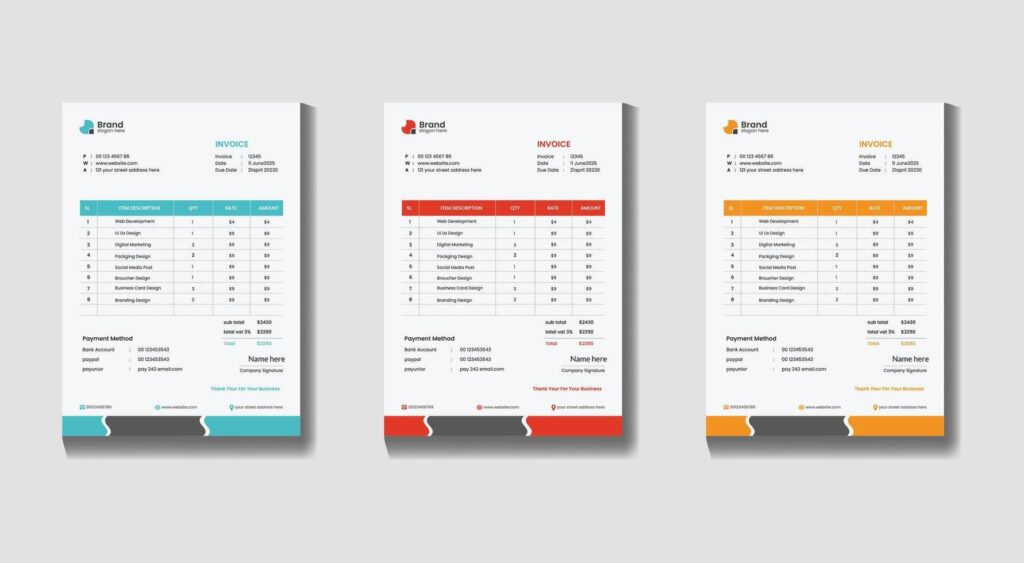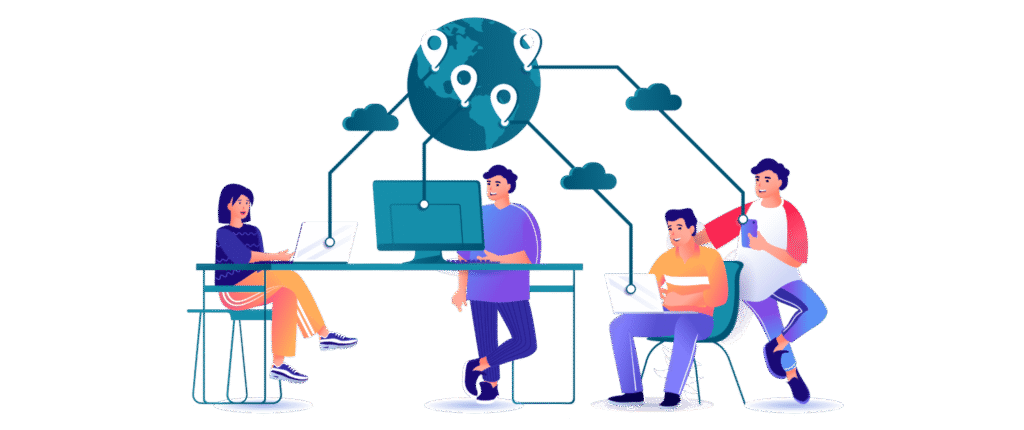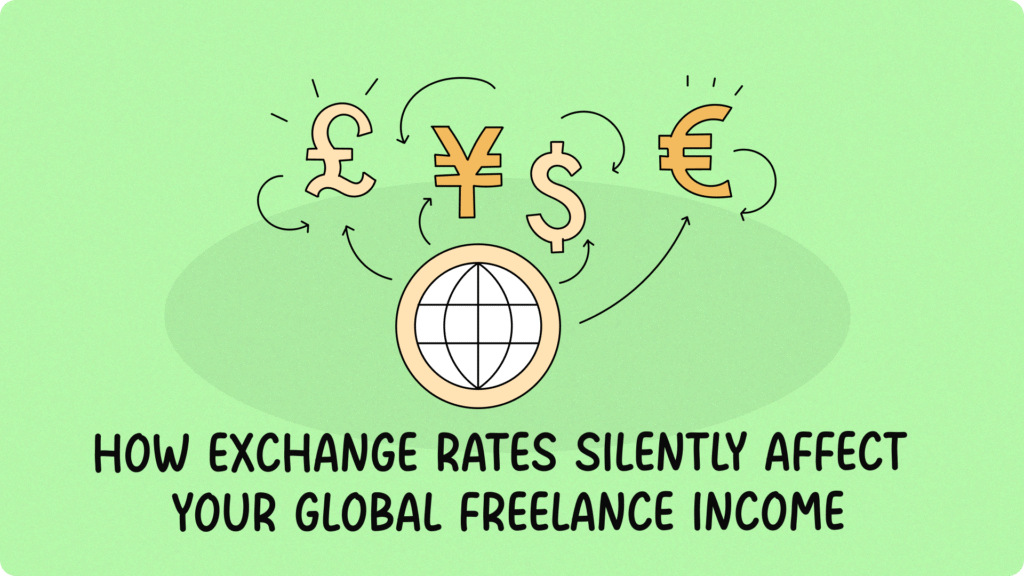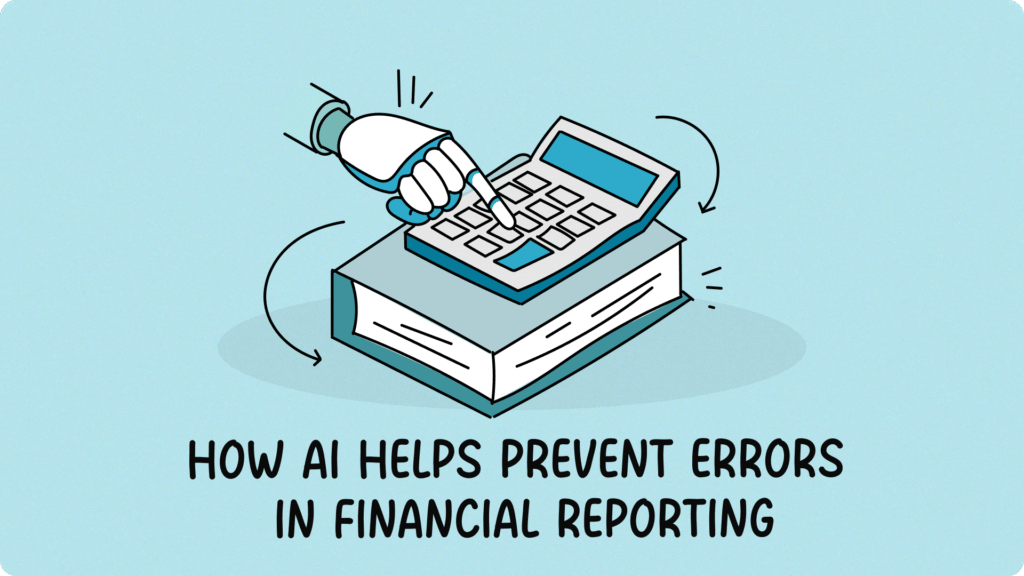Say Goodbye to Messy Word Docs: 5 Free Ways to Create Professional Invoices

You’ve just exported the final file, closed the 17 browser tabs you’ve had open for a week, and hit “Send” on the final deliverable. You lean back in your chair, take a deep breath, and feel the weight of the project lift off your shoulders. But before you can fully celebrate, there is one last administrative hurdle: asking for the money. For many of us, this part feels awkward. We rush through it, typing a few lines into a document and hoping it looks “official enough.” But the reality is, your invoice is the final handshake of your project. It’s the last impression you leave. Sending a polished, branded invoice does more than just look good—it changes the power dynamic. Data suggests that you are 3x more likely to get paid simply by adding a company logo to your invoice. Psychologically, a sharp invoice signals, “I take my business seriously, and I expect you to do the same.” Here are 5 completely free ways to upgrade your invoicing today, ranked from the simplest quick-fix to fully automated systems. In this article 1. Free Online Invoice Generators Sometimes you just need to send one invoice, right now. You don’t want to sign up for a new platform or remember another password; you just need a PDF that doesn’t look like it was made in 1999. Quick Tip: Look for generators that allow you to change the currency symbol if you are working with international clients. Sites like Invoice Generator or Shopify are great places to start. 2. Google Docs & Sheets Templates If you are just starting out and want total control over every pixel, the Google Workspace gallery is likely your best friend. It is accessible, cloud-based, and you likely already use it for your actual work. Quick Tip: Always export as a PDF before sending. Sending an editable Google Doc looks unprofessional and allows clients to accidentally (or intentionally) change the figures. 3. Canva Templates Who says invoices have to be boring spreadsheets? If you are in a creative field—graphic design, social media management, or photography—your invoice is another piece of your portfolio. It should look as good as your work. Quick Tip: Create a “Master Template” in Canva so you don’t have to re-design it every time. Just duplicate the page and update the line items. 4. Stripe or PayPal Invoicing If your priority is getting money into your bank account fast, you might want to skip the PDF attachment entirely and send a digital invoice directly through your payment processor. Quick Tip: Enable “recurring invoices” if you have clients on a monthly retainer. The system will bill them automatically without you lifting a finger. 5. Dedicated Invoicing Software (Wave, Zoho, Fynlo) Eventually, manual templates and fees become a bottleneck. If you are sending more than 5 invoices a month, you need a system that automates your entire billing workflow—remembering your clients, numbering your invoices, and chasing payments for you. Quick Tip: With Fynlo’s Forever Free plan, you get a professional dashboard that tracks invoice views. This means a client can never use the excuse “I didn’t get the email” again, because you’ll know exactly when they opened it. Make Getting Paid the Easy Part Professionalism doesn’t have to cost money, but looking amateur will cost you opportunities. As your workload grows, tools that automate invoicing, reminders, and tracking can make a noticeable difference. Exploring a dedicated invoicing platform like Fynlo is a simple next step if you want fewer follow-ups and more predictable payments. Book a free demo to see how Fynlo might fit into your day-to-day. You may also like these articles:
The 5 Biggest Accounting Trends That Will Define Business Survival in 2026

If you feel like the rules of doing business are changing faster than you can keep up, you aren’t alone. For freelancers and small business owners, 2026 is shaping up to be a turning point. We are finally moving away from the era of “I’ll get to that paperwork later” and into a world where automation is the standard and compliance is non-negotiable. We have dug into the latest government budgets and global industry reports to bring you the five biggest shifts hitting the accounting world in 2026. Here is what you need to know to stay ahead. In this article 1. Mandatory E-Invoicing Is Going Global First, let’s clear up a common misconception: E-invoicing is not just emailing a PDF. When you send a PDF, it is essentially a digital piece of paper—a human still has to open it, read it, and type the numbers into their system. True e-invoicing is data, not a document. It involves sending structured files (like XML) directly from your software to your client’s software (or the government’s), where it is read and processed instantly without human hands touching it. Governments love this because it closes tax gaps, and now they are making it the law across the globe. If you work with clients in these regions, your current method of invoicing might become obsolete. You will likely need software that generates these specific machine-readable formats automatically to ensure you can still get paid. 2. AI Will Supercharge Your Financial Productivity Ignore the doom-and-gloom headlines about robots taking jobs. In 2026, AI is less about replacing you and more about giving you your weekends back. The technology has matured from a “cool experiment” to a daily essential for cutting down busy work. 3. Late Filing Penalties Are Increasing Governments are getting smarter. They are using better data to spot mistakes faster, and the leniency we saw in previous years is disappearing. 4. The Rise of Deepfakes is Creating New Cybersecurity Risks Small businesses often think they are too small to be targeted by hackers. Unfortunately, as large corporations tighten their security, attackers are pivoting to smaller, easier targets using terrifyingly realistic tech. 5. Remote Work is the New Standard (But It’s Hybrid) The concept of having your accountant “down the street” is fading. Business owners are increasingly prioritizing talent and tech-savviness over physical proximity. Future-Proof Your Business with Fynlo The common thread across all these trends is technology. Whether it is meeting new e-invoicing mandates, staying on top of deadlines to avoid steeper penalties, or leveraging AI to save time, you need tools that evolve as fast as the world does. That is why we are excited to introduce the recently launched Fynlo AI. We built Fynlo AI to directly address the productivity and accuracy challenges mentioned above. It allows you to simply upload receipts or bank statements, and our engine takes over from there. Fynlo AI extracts the data, categorizes every entry, and updates your financial reports in real-time with 100% accuracy. No more manual data entry errors, no more late nights classifying expenses, and no more guessing where your business stands. Ready to get ahead of the 2026 trends? Schedule a demo today and experience the future of automated accounting. You may also like these articles:
5 Financial Metrics Your Bank or Lender Will Check Before Giving You a Loan

You’ve poured your time, energy, and sleepless nights into building something strong. You’ve overcome the initial hurdles, found product-market fit, and now you’re ready for the next big leap. That means securing the capital required to hire, expand your inventory, or move into a bigger space. This journey, though, brings you face-to-face with a tough reality: obtaining that financing is often the single biggest hurdle for small businesses. According to 2025 research from Allica Bank, SME loan rejections have dramatically increased from just 5-10% three decades ago to 40% today. In other words, lenders are far more selective than they used to be. The moment you submit that application, you step into a rigorous due-diligence process where lenders are looking past your gross revenue to assess two critical things: risk and repayment capacity. If you don’t know the core metrics they care about, you can’t prepare your books effectively or present your case with confidence. Here are the five essential financial metrics your bank will scrutinize before approving your loan. In this article 1. Quick Ratio (Acid-Test Ratio) Think of the Quick Ratio as your company’s emergency financial safety net. It’s a crucial measure of short-term liquidity, answering the question every lender silently asks: “If sales hit a sudden wall, could this business instantly pay its most urgent bills?” This metric focuses only on your most liquid assets—cash and receivables—and deliberately excludes inventory because that can be slow to sell or difficult to liquidate quickly. Lenders generally look for a Quick Ratio above 1.0. A strong Quick Ratio proves you have the immediate cash flow cushion to weather an unexpected storm, which builds confidence in your business’s foundational health. To put it simply: if you owe $10,000 in short-term bills, lenders want to see at least $10,000 in highly liquid assets; ideally more. Quick Ratio = (Cash + Accounts Receivable + Marketable Securities) / Current Liabilities 2. Debt-to-Equity (D/E) Ratio The D/E Ratio measures the financial structure of your business. It answers whether you’re funding growth primarily through debt or through the owners’ investment (equity) and accumulated profits. Lenders look for a lower ratio, typically below 1.5. A high D/E ratio (say, 3.0) signals that your business is highly leveraged and therefore vulnerable if revenues dip, as fixed debt payments remain relentless. Conversely, a low ratio proves the owners are committed and the company has strong internal stability. Debt-to-Equity Ratio = Total Liabilities / Total Equity 3. Debt Service Coverage Ratio (DSCR) When a bank considers giving you a new loan, DSCR is what matters most. It is arguably the most critical metric for any new debt, measuring your company’s direct repayment capacity for all its debt obligations. DSCR = Net Operating Income / Total Debt Service (Principal + Interest Payments) Banks usually require a DSCR between 1.25 and 1.50. Think of this simply: a DSCR of 1.25 means your operating income is 125% of your required debt payments. This provides a safety margin. If your DSCR is below 1.0, the loan conversation stops instantly—you’re simply not generating enough income to cover your required payments. 4. Gross Profit Margin While the initial metrics focus on risk, the Gross Profit Margin proves the viability of your core business model. It answers: “How profitable is your product or service itself, before the lights are even turned on?” Lenders look for a high and consistent margin. A strong Gross Profit Margin proves that your core service is priced correctly and that you are efficient at managing your direct production costs (COGS). This shows the inherent earning power of your product, assuring the lender that even if overhead expenses rise, the core offering is financially sound. Gross Profit Margin = (Revenue – Cost of Goods Sold) / Revenue 5. Accounts Receivable (A/R) Aging and DSO This metric focuses on cash flow quality and the efficiency of your collections process. A healthy balance sheet is useless if you can’t actually get the money in the door. Lenders pay close attention to your A/R aging report to see how many outstanding invoices are over 90 days due. If a large percentage of your revenue is perpetually uncollected, that’s a massive red flag. Days Sales Outstanding (DSO) measures the average number of days it takes for you to collect revenue after making a sale. DSO = (Average Accounts Receivable / Total Credit Sales) x Number of Days Lenders want to see a low DSO, indicating fast and efficient collection (ideally under 45 days). A high DSO suggests your credit control is weak or your clients are unreliable, significantly raising the lender’s risk profile. Your Strategic Decision Securing a loan starts long before you submit the application. It begins with accurate, organized financial reporting. These five metrics are calculated directly from your Balance Sheet and Profit & Loss Statement. Trying to compile this data manually using spreadsheets is tedious and prone to error, which immediately hurts your credibility during a loan review. The businesses that secure the best rates are the ones that can provide clean, real-time reports instantly and confidently. Fynlo provides the clear, real-time financial reports you need to confidently demonstrate your stability and repayment capacity to any lender. Stop worrying about compiling data; start focusing on growth. Schedule a quick demo today to ensure your books are audit-ready and lender-approved. You may also like these articles:
Should You Lease or Buy Equipment? A Financial Breakdown

Every small business owner hits a wall where their old equipment just won’t cut it anymore. Maybe it’s time for a faster work truck, a major new piece of machinery, or simply upgrading every laptop in the office. This decision isn’t just about whether you have the cash today; it’s one of the most important financial choices you’ll make all year. The question of whether to lease (rent) or buy (own) directly impacts your immediate cash flow, your tax bill, and the overall look of your company’s financial health. Understanding the difference is the first step toward making a profitable move. In this article The Case for Buying (Financing or Ownership) When a business buys equipment, it usually means taking out a loan to cover the cost. You own the asset outright, and it immediately goes onto your Balance Sheet. The Tax Advantage: Depreciation The biggest financial benefit of buying is that you get to claim the entire purchase price as an expense over the asset’s useful life. This is called depreciation. It’s a wonderful non-cash deduction that essentially gives you a massive tax break. For example, in the United States, rules like Section 179 allow you to deduct the full purchase price of some assets immediately. No one wants a surprise bill from the tax authorities, and claiming depreciation is a straightforward way to reduce your taxable income. Cash Flow and Final Cost While the upfront cost might be higher or require a significant down payment, the long-term benefit is that you build equity. Once the loan is fully paid off, the asset is yours free and clear. If you use the equipment for ten years, your total cost of ownership (after taxes) can often be lower than renting it for the same period. The Case for Leasing (Renting or Operating) Leasing is essentially renting the equipment for a set period, typically three to five years. This option is popular because it minimizes risk and keeps things simple. Flexibility and Low Upfront Cost The primary appeal of leasing is the minimal initial expense. You usually don’t need a large down payment, making it ideal if your business needs to preserve cash liquidity for other operating expenses, like marketing or inventory. Because you don’t own the asset, when the lease is up, you simply hand the old equipment back and upgrade to the newest model, which is perfect for rapidly changing technology like computers or software licenses. Accounting Simplicity From an accounting perspective, leasing is straightforward. Your monthly lease payment is treated as a simple operating expense, similar to paying rent. It goes directly onto your Profit and Loss (P&L) Statement, reducing your gross profit immediately. This process is far less complicated to track than the depreciation schedules required when you buy. Decision Matrix: Choosing the Right Path The ideal choice depends entirely on your company’s needs and long-term outlook. When to Buy (Stability is Key): When to Lease (Flexibility is Key): Accounting Impact: How Each Choice Affects Your Statements Regardless of which path you choose, you need an organized system to track the financial consequences correctly. Buying is more complex to track. When you buy, you must record the full asset value and the corresponding liability (the loan) on your Balance Sheet. Then, your accounting system needs to correctly calculate and post the depreciation entries monthly or annually, following local tax rules. This meticulous tracking is essential if you ever need to apply for a loan, as banks will heavily scrutinize your Debt-to-Equity ratio. Example 1: Buying (The Balance Sheet Impact) When you buy a $10,000 piece of equipment with a loan, your books change immediately and permanently: Account Effect Statement Value Equipment Asset Increases Balance Sheet + $10,000 Loan Payable Liability Increases Balance Sheet + $10,000 Annual Depreciation Expense Increases P&L Statement + $1,000 Accumulated Depreciation Asset Value Decreases Balance Sheet + $1,000 The Takeaway: Buying creates a complex tracking relationship between the Balance Sheet (Asset/Loan) and the P&L (Depreciation). Leasing keeps your Balance Sheet clean. Since leasing is treated as an operating expense, the monthly payment only touches your P&L statement. It avoids adding large debt obligations to your books, which can sometimes be advantageous if your company is trying to stay lean to secure a future loan or meet specific financial covenants required by lenders. Example 2: Leasing (The P&L Simplicity) When you pay a $300 monthly lease payment, the transaction is simple and only affects two things: Account Effect Statement Value Lease Expense Expense Increases P&L Statement + $300 Cash Asset Decreases Balance Sheet – $300 The Takeaway: The cost is immediate, transparent, and easy to track, requiring no complex depreciation schedules. Your Strategic Decision The decision to lease or buy equipment is a strategic one, balancing immediate cash needs against long-term tax and ownership benefits. It requires careful tracking of depreciation schedules, loan balances, and expense categories. Don’t let these complex entries be a source of error or confusion. You need a system that ensures your fixed assets are tracked accurately, your depreciation is automatically calculated, and your financial reports are audit-ready, whether you are owning an asset or simply renting its use. Ready to gain control over your assets and deductions? Schedule a quick demo today to see how Fynlo simplifies fixed asset management, expense tracking, and financial reporting for growing businesses. You may also like these articles:
Free Alternatives to QuickBooks/Xero: The Best Free Accounting Tool for Micro-Businesses

Running a micro-business or a growing freelance operation means constantly balancing costs against value. You know you need professional accounting software—you need reports, tax compliance, and clean books. Yet, paying a monthly subscription for QuickBooks or Xero when your income is still irregular can feel like an unnecessary burden. You’re looking for a free alternative, but the search can be overwhelming. There are dozens of tools out there, and finding one that is truly free and powerful enough for a real micro-business is a challenge. The right tool is a strategic investment; it saves you time and ensures you build the solid financial foundation you need for future growth. Here, we review the top genuinely free alternatives available today. We look at their core features, limitations, and help you find the best starting point for your micro-business. Table of Contents Top 5 Truly Free Accounting Alternatives These platforms all offer a permanently free tier, making them excellent starting points for sole traders and service-based freelancers. Tool Primary Free Plan Name Best For Key Free Limitations Wave Starter Plan Purely Free & Simple (US/CA Focus) Bank feeds, receipt scanning, and some invoice customization require paid plan. Zoho Books Free Plan Scalability & Feature Depth Annual revenue limit applies; bank feeds, receipt scanning, and invoice customisation require paid plan. QuickFile XS, S and M UK-Based Low-Volume Transactions Limited to 1,000 nominal transactions per year. Pandle Pandle Free Unlimited Core Functionality Automated bank feeds and receipt uploads are reserved for the paid plan. Fynlo Forever Free Global Freelancers & Multi-Currency Limited to 20 monthly invoices; budget management and online payments require paid plan. Note: Platform features and pricing may change. Before starting a free trial, check the provider’s website for the latest service details and fees. 1. Wave Wave offers its accounting tools under the Starter Plan and is widely considered the best truly free option for freelancers and small businesses in the US and Canada. It has helped more than 5.9 million small business owners in the US and Canada manage their money since 2010. This plan includes unlimited invoicing, expense tracking, and basic financial reports. Bank feed automation and receipt scanning are not included in the free plan and require upgrading to Wave’s paid tier. Wave generates revenue through payment processing fees when clients pay invoices via credit card or ACH. https://www.waveapps.com 2. Zoho Books Zoho Books is part of a much larger ecosystem of business software, giving it a powerful advantage in scalability. It has 4.6/5 rating on G2 CROWD and 4.7/5 rating on SoftwareSuggest. The Free Plan is generous but comes with a clear cap: it is limited to a single user, a single accountant, 1,000 invoices per year, and you cannot exceed an annual revenue threshold limit which is set specifically for each region (e.g., $50,000 in the USA and £35,000 in the UK). If you are starting small and plan to stay small, this plan is excellent, offering features like a client portal and multi-lingual invoicing. Multi-currency handling, bill management, and automated bank feeds are typically locked into their paid tiers. https://www.zoho.com/books/free-accounting-software 3. QuickFile While primarily focused on the UK market, QuickFile is noteworthy for its feature-rich free plan. It receives 4.8/5 rating on TrustPilot, based on 2,940 reviews. The software is completely free as long as your 12-month nominal ledger transaction volume stays under 1,000. For a sole trader with low transaction volume, the free plan is exceptionally powerful, offering full multi-currency support and VAT/ITSA compliance tools (which are crucial for UK users). If you exceed 1,000 transactions, an annual fee of £60 plus VAT will apply. https://www.quickfile.co.uk 4. Pandle Pandle has more than 100,000 active users and has 4.6/5 rating on Trustpilot based on 1,290 reviews. Pandle offers its Free Plan with a strong focus on simplicity and unlimited core usage, meaning there are no limits on revenue or the number of invoices you can issue. The free tier includes invoicing, basic financial reports, and multi-currency support. As with many platforms, key automation features such as bank feeds (automatic transaction imports) and receipt uploads are reserved for the paid Pandle Pro version, which costs £5 per month plus VAT. This is an excellent choice for businesses prioritizing unlimited core functionality. https://www.pandle.com (Note: This is a UK-focused product.) 5. Fynlo Fynlo has a growing user base in the USA and Asia region. Thousands of businesses find that it makes invoicing and expense tracking simple and the service reliable. Fynlo is designed specifically for global freelancers and micro-businesses, meeting the need for robust multi-currency tracking without complexity. Its Forever Free plan provides up to 20 monthly invoices, expense tracking, Core Multi-Currency reporting, and access for 1 user plus 1 accountant. This makes it one of the best free options for entrepreneurs who receive or pay in different currencies. Certain advanced features, like accepting online payments and budget management, are reserved for our paid tiers to ensure high-level compliance as your business scales. https://www.fynloapps.com The Functional Limitations of Free Accounting Software Free” is a perfect place to start, allowing you to experiment and see which platform’s features and interface suit your working style. As you grow, you would need to be aware of the limitations that make the paid versions of accounting tools a worthwhile investment. Some common paid features include Bank Feed Automation, Multi-Currency Tracking and FX Gains/Losses, and Hard Limits on Revenue, Users, or Transactions. Bank Feed Automation The primary feature restricted in most free plans is Bank Feed Automation. This means the platform will not automatically import and categorize your transactions from your bank. While manual entry works for very low volume, spending hours every month manually entering or uploading transactions can be a major drain on your time—time that is better spent earning revenue. Multi-Currency Tracking and FX Gains/Losses This is the single biggest failure point for most free accounting software. If you deal with international clients, free platforms often do not automatically calculate Foreign Exchange (FX) Gains and Losses needed for accurate reporting. This complex calculation must then be done manually (often in a messy spreadsheet), significantly increasing your risk of tax mistakes. Hard Limits on Revenue, Users, or Transactions As tools like Zoho Books show, many platforms impose a hard revenue limit. If you
5 Outsourced Activities That Unlock Freelancer Growth

Running a business is exciting, but it’s also overwhelming at times. Most entrepreneurs start with the best of intentions, believing they can (and should) handle everything themselves. It’s natural. Your business is your baby, and trusting outsiders can feel risky. But as your client list grows and responsibilities multiply, doing it all solo starts to limit your potential. That’s where strategic outsourcing comes in. It’s not about giving up control, but about getting the freedom to focus on what truly drives growth. In 2025 and beyond, outsourcing is no longer something just “big companies” do. Small businesses and freelancers are using it to save costs, access expertise, and scale faster. In fact, recent surveys show that around 37% of small businesses now outsource at least one business process, reflecting how outsourcing has become a mainstream growth strategy rather than a last resort. Here are five key areas every small business owner should consider outsourcing to stay competitive and efficient. Table of Contents 1. Accounting and Bookkeeping If you only choose to outsource one function, make it this one. Accounting is the backbone of every business, but it’s also one of the most time-consuming and error-prone. A small mistake can snowball into penalties or compliance issues. According to a study by the U.S. Internal Revenue Service (IRS), about 33% of businesses make payroll-related errors each year, often due to miscalculations or missed deadlines. Partnering with a qualified accounting service dramatically reduces that risk and ensures your books stay accurate, up to date, and tax-ready. What outsourcing can do for you: Modern accounting platforms like Fynlo also make outsourced bookkeeping seamless, allowing you to share data securely and monitor progress in real time. 2. Payroll Management Payroll is deceptively complex. Between changing tax codes, employee benefits, and international compliance (if you hire globally), it’s easy to get buried in spreadsheets. Late payments or incorrect deductions can harm your reputation and trigger costly penalties. Outsourcing payroll ensures employees are paid accurately and on time, while taxes, filings, and deductions are handled correctly. Many payroll providers also manage compliance with evolving employment laws across multiple regions — something that can be challenging for small teams to keep track of. Key benefits: If your business is expanding across borders or hiring contractors abroad, outsourced payroll is more than a convenience, it’s a safeguard. 3. IT Support and Cybersecurity In today’s digital landscape, IT isn’t optional. Yet maintaining your own IT department can be expensive and unnecessary for smaller operations. Outsourced IT providers offer scalable, professional support for everything from system maintenance to data protection. Cybersecurity, in particular, has become a pressing concern. According to IBM’s 2024 Cost of a Data Breach Report, the average cost of a breach reached USD 4.88 million, and small businesses are increasingly being targeted because they often lack strong defenses. What outsourcing IT can include: For small teams, outsourcing IT delivers peace of mind and enterprise-level protection without the cost of full-time staff. 4. Marketing and Content Creation You could be offering the best product or service in your niche, but if your marketing falls flat, no one will know. Outsourcing marketing doesn’t mean losing your voice; it means amplifying it with expertise in strategy, content, and analytics. External marketing agencies or freelancers can help you refine your brand voice, manage social media consistently, and create content that converts. They bring fresh perspectives and technical know-how, from SEO optimization to paid advertising strategies. When to outsource marketing: With remote collaboration tools, you can now manage outsourced marketing as seamlessly as if the team were in-house. 5. Administrative Support and Customer Service Many small business owners underestimate how much time is lost on repetitive administrative tasks: responding to emails, scheduling, data entry, and managing customer inquiries. While these tasks are essential, they don’t directly generate revenue. Virtual assistants (VAs) and outsourced customer support teams can handle these repetitive duties efficiently and professionally. That allows you to focus on strategy, business development, and client relationships; the areas that truly grow your business. Top tasks to outsource: Even a few hours of outsourced admin support each week can reclaim your time and reduce mental clutter. Outsourcing as a Growth Strategy Outsourcing doesn’t mean you’re losing control of your business. It means you’re using your resources wisely, choosing to invest your time in high-impact work while professionals handle the rest. Whether it’s bookkeeping, payroll, marketing, or IT, delegating to experts can save you money, reduce risk, and give you back the freedom to focus on growing your business. Fynlo helps freelancers and small business owners streamline accounting and financial management with smart automation and seamless integrations. Explore how Fynlo can complement your outsourced team and keep your finances stress-free. Try a free demo today and see how modern accounting software makes outsourcing simpler, faster, and smarter. You may also like these articles:
The Ultimate Year-End Accounting Checklist for Small Business Owners

The end of the year isn’t just about wrapping projects; it’s the critical moment to finalize your finances, maximize every deduction, and ensure you’re compliant, no matter where your clients or operations are based. Skipping this process can lead to costly errors, audit triggers, or missed opportunities to save money. Let’s be honest: most small business owners would rather focus on clients than spreadsheets. But investing just a few focused hours now can save you weeks of cleanup, stress, and last-minute panic later Year-end accounting can feel like a marathon, but this structured checklist will help you stop scrambling, clean your books confidently, and kick off the new business cycle with peace of mind. Table of Contents Step 1: Define Your Timeline and Filing Deadlines Before you start any data entry, you must confirm your accounting year. For many small businesses globally, the fiscal year aligns with the calendar year (ending December 31st), which is standard for sole proprietorships and LLCs in the USA or freelancers in many parts of Asia. However, some countries or business structures, like many companies in the Philippines or large corporations worldwide, choose a different period, such as an April 30th or June 30th year-end. Once your year-end date is set, you need to immediately confirm your official tax filing and account submission deadlines with the relevant tax authority. For instance, in the UK, a private limited company that files its accounts more than 6 months late can face an automatic penalty of up to £1,500. Knowing your exact deadline well in advance gives you the power to plan properly and avoid unnecessary fines. Step 2: Ensure Complete Data Capture of All Records The foundation of accurate financial reporting is complete data. This cleanup phase requires you to meticulously gather all transaction records, ensuring every piece of the puzzle is accounted for. Make sure all your income is recorded, whether from invoices issued or direct payments received. Crucially, you must record every single expense. Go beyond the obvious software fees and office supplies to include less visible costs, such as home office expenses, mileage allowances, and depreciation. If you’re a global freelancer dealing with different currencies, confirm you’ve captured all foreign income and expenses, as missing these details can lead to understating your true cost of doing business. Step 3: Reconcile Every Bank and Payment Account Reconciliation is the process of matching every entry in your accounting system to your official statements. You must verify that the final balance in your ledger precisely matches the closing balance for the last day of the fiscal year across all your accounts: bank accounts, credit cards, and payment processors like PayPal or Stripe. During this review, you’re looking to clear up any discrepancies. This includes chasing any old deposits or checks that haven’t cleared the bank yet. If you find unexplained fees or transfers, allocate them now to the correct expense category. A clean reconciliation ensures your books are grounded in reality and ready for audit. Step 4: Value Inventory and Calculate Cost of Goods Sold If your business sells physical products, this step is mandatory. You need to conduct a physical count or stocktake of all products, materials, and supplies on hand at the close of the fiscal year. This value is critical because it directly determines your Cost of Goods Sold (COGS). An accurate COGS figure is essential for determining your gross profit and ultimately your net income. Any error here—either overstating or understating your inventory—will directly result in misstating your profitability and, therefore, your tax liability. This step requires precision and shouldn’t be guessed. Step 5: Update Fixed Assets and Post Depreciation Businesses rarely use their assets up in a single year, so you need to account for their ongoing wear and tear. Review all your Fixed Assets (like computers, machinery, or vehicles) and record any new purchases made during the year. The main action here is calculating and posting the depreciation expense. This non-cash deduction recognizes the expense of using an asset over its useful life, and it reduces your taxable income globally. Ensure you’ve applied the correct depreciation method (straight-line, declining balance, etc.) required by your local tax authority. Step 6: Resolve All Outstanding Client Invoices (Receivables) Before closing the books, you need a realistic picture of the money owed to you. For invoices you’ve issued but not yet received payment, list these as trade receivables. You need to analyze the likelihood of collection. Any invoices that are significantly overdue (e.g., 90 days or more) and clearly uncollectible should be flagged for potential bad debt write-off. Writing off bad debt is a legitimate accounting practice that helps clean your Accounts Receivable and can reduce your taxable income, although the specific rules vary by jurisdiction. Step 7: Record All Unpaid Bills (Accounts Payable) Accounting principles require you to record expenses in the period they were incurred, not just when you paid them. You must ensure you’ve recorded all vendor invoices and bills received before the year-end date, even if the payment isn’t due until the next year. Recognizing these trade payables gives you a more accurate picture of your true profitability and current liabilities for the year, adhering to the crucial matching principle of accounting. Failing to record these outstanding bills will overstate your profit and potentially lead to overpaying taxes for the closed year. Step 8: Handle Multi-Currency Gains and Losses If your business operates globally or uses multi-currency bank accounts, you face the complexity of foreign exchange (FX) fluctuations. When you finally convert foreign funds (like Euros or Pounds) into your home currency, the exchange rate will likely have changed since the invoice date, resulting in either a gain or a loss. You must calculate and record these realized gains or losses for the fiscal year. This is a critical step for compliance in global reporting, as tax authorities require accurate tracking of these figures. If exchange rates have been quietly eroding your revenue, check out our guide on managing
Stop Losing Money: How Exchange Rates Silently Affect Your Global Freelance Income (And the Simple Fixes)

If you run a freelance business or a small company that serves clients across borders—from London to Sydney, or Tokyo to Berlin—you’ve likely faced an invisible threat: exchange rate volatility. Every time a foreign payment lands in your bank, its value might have shifted. These small, daily movements in foreign exchange (FX) rates can quietly eat into your revenue, disrupt your budget, and turn a profitable contract into a financial annoyance. You delivered the work perfectly, yet the currency market took a cut. Understanding how to neutralize this currency risk isn’t just for big corporations; it’s essential for maintaining control over your cash flow and safeguarding your growth. Table of Contents Why Currency Risk Is a Critical Problem Right Now The days of stable, predictable exchange rates are largely behind us. In recent years, central bank policies, geopolitical events, and high inflation cycles have made currency markets far more volatile. A survey by Convera also found that “currency volatility and conversion costs” rank among the top challenges for businesses managing cross-border payments, underscoring how widespread and persistent this issue has become. Whether it’s the U.S. Federal Reserve hinting at interest rate changes (which immediately affects the strength of the dollar globally) or political uncertainty in Europe causing sudden shifts in the Euro and Pound Sterling, these external factors have real-world consequences for your business. For example, during sharp market movements, the EUR/USD rate can shift significantly in just a few months. When the currency your client pays you in weakens against your local currency, you receive fewer dollars, euros, or pounds back home. This loss, known as FX exposure, is the price of doing international business if you don’t manage it proactively. The Core Loss: How Timing Eats Your Profit When you invoice a client in their local currency, you face two risks: the day you issue the invoice, and the day you receive payment. Let’s look at how that timing gap can cost you money. Example: A graphic designer based in the Eurozone (Home Currency: EUR) completes a consulting project for a client in the UK (Foreign Currency: GBP) for an agreed value of €5,000 EUR. Scenario Date Exchange Rate (EUR to GBP) EUR Equivalent Received Contract Signed January 1st £0.85 GBP per €1 EUR (Equivalent to approx. £4,250) Payment Expected February 1st £0.85 GBP per €1 EUR €5,000 EUR Payment Received February 1st £0.88 GBP per €1 EUR €4,830 EUR In this scenario, the Euro strengthened, meaning it took more Pounds (£) to buy one Euro (€). Because the client was locked into paying the Pound equivalent of the original invoice, the designer lost €170 of expected revenue—a real loss caused entirely by a small market movement. The Hidden Drain: Where Your Money Disappears Exchange rate losses often occur subtly, in ways that are hard to spot in a simple P&L statement. For freelancers and small business owners focused on growth, these losses usually hit in three key areas: 1. Quoting and Invoicing Risk The moment you issue a quote or an invoice valid for 30 or 60 days, you’re essentially making a short-term bet on currency stability. If you invoice in a weaker currency, and that currency dips further before the payment arrives, your original price loses purchasing power back in your home currency. Best practice: Protect your margin by pricing with a small currency buffer or shortening payment windows. 2. The Cost of Conversion Fees When a payment moves from your client’s foreign bank account to your local bank, it passes through intermediaries—often a major bank or a payment processor like PayPal. These entities rarely use the mid-market rate (the true rate you see on Google). Instead, they apply a conversion rate margin that can be 1–5% worse than the real rate. This margin is an invisible fee that ensures you lose money every time you convert funds, often buried deep in transaction summaries. Best practice: Always compare conversion rates and consider borderless payment platforms to minimize hidden costs. 3. Paying International Subscriptions and Suppliers Your business might rely on premium software, cloud services, or raw materials billed in foreign currencies. When your home currency suddenly weakens—say, the Australian Dollar against the USD—those subscription fees and supplier payments immediately become more expensive. If you budgeted $100 a month for your software stack, a 5% currency shift means you’re suddenly spending $105, tightening your margins without warning. Best practice: Track recurring foreign expenses so you can adjust pricing or timing before exchange rate shifts erode your profit. Simple Strategies to Protect Your Cash Flow You don’t need a Wall Street trading floor to manage FX risk—just smart terms and the right tools. Here are practical strategies to strengthen financial control: Strategy 1: Lock in Your Price by Quoting in Your Home Currency The easiest way to eliminate currency risk is to shift that risk to your client’s side—gently and professionally. By stating the final price and invoice amount in your home currency (HC)—whether that’s USD, CAD, EUR, or AUD—you ensure the amount you receive is fixed. The client’s bank or payment service will handle the conversion on their end, meaning they bear the risk if the market shifts. This approach offers immediate clarity and guarantees that your profit margin remains exactly what you planned, though you must be prepared for the occasional client who prefers paying in their local currency. Strategy 2: Use Multi-Currency Accounts to Time Your Conversions If your clients insist on paying in their local currency (which is common, especially with large corporate clients), your best move is to avoid immediate conversion. Set up a borderless or multi-currency account using modern payment services. When your client pays in Euros or Yen, the funds stay in that currency until you decide to convert—ideally when the rate is more favorable. You can even use those foreign funds directly for subscriptions or suppliers abroad (a form of natural hedging). This strategic patience can save you hundreds, or even thousands, over a year. Strategy 3: Add a Professional FX Clause in Long-Term Contracts For lengthy projects, large retainers, or annual contracts, currency risk can become significant. A professional contract should share this burden. You
How AI Helps Prevent Errors in Financial Reporting

Even the most careful business owners make mistakes now and then. A duplicated entry, a missing invoice, or a miscategorized expense can quietly throw off your entire picture of profitability. The challenge isn’t just human error, but the sheer amount of detail involved in keeping financial records accurate every single day. That’s where Artificial Intelligence (AI) is making a meaningful difference. Modern accounting tools use AI to catch inconsistencies, flag unusual patterns, and automate repetitive checks that once took hours of manual review. The result is fewer errors, faster reporting, and greater confidence in your numbers. According to a 2024 analysis by GlobalFPO, about 58% of accounting firms had already adopted some form of AI to improve efficiency and accuracy in their workflows, with many reporting measurable gains in speed and error reduction. Whether you’re a freelancer managing multiple clients or a small business owner keeping an eye on growth, understanding how AI improves accuracy can truly transform the way you manage your finances. Here’s how AI-driven accounting systems help stop financial errors before they start. Table of Contents 1. Automated Data Capture Keeps Human Error in Check The first step to accurate reporting is clean data entry. Most financial mistakes begin right here: typos, missing receipts, or mismatched invoices. AI helps eliminate those weak spots by automating the capture process. Using Optical Character Recognition (OCR) and machine learning, AI can scan invoices, instantly pull out the right information, and record it automatically. For instance, if you snap a picture of a receipt, the system identifies the vendor, date, and amount, then knows how to categorize it correctly. This drastically reduces manual input and ensures consistency from the start. The fewer times you type something in, the fewer chances there are for mistakes to creep in. 2. Continuous Reconciliation Catches Discrepancies Early Traditionally, reconciliation happens once a month, often at the worst possible time when you’re already swamped trying to close the books. AI changes that by continuously comparing your bank, credit card, and ledger records in real time. If an entry doesn’t match or looks suspicious (like a surprisingly large transfer to a new vendor), the system immediately alerts you. That early detection allows you to fix small discrepancies right away, preventing them from distorting your final reports. This ongoing reconciliation also builds confidence: when you check your balances mid-month, you know they reflect reality, not last month’s lingering problems. 3. Smarter Categorization Improves Consistency Misclassifying transactions is one of the most common causes of inaccurate reporting. Recording a long-term asset as an expense, or putting a large software invoice in the wrong bucket, might seem minor, but over time, it adds up. With machine learning, your system learns your habits and applies them consistently. Over time, it recognizes how you typically categorize expenses and automatically suggests the right category. If something seems off, it flags the entry before it causes confusion. For example, if you consistently log software subscriptions under “Technology,” but a new one gets placed in “Office Supplies,” AI can prompt you to take another look. This small adjustment helps ensure your data stays clean and comparable month after month. 4. Anomaly Detection Identifies Hidden Irregularities Some financial errors are too subtle for the human eye to notice. Modern AI tools excel at spotting irregularities by scanning thousands of transactions and recognizing patterns that don’t align with your usual activity. Let’s say your company usually pays similar invoices between $300 and $500 each month. If one suddenly jumps to $2,000, AI will flag it instantly. Tools use this capability to quickly detect fraud, duplicates, or simple posting mistakes long before they show up in an audit. By catching irregularities early, you prevent small errors from snowballing into larger financial risks. 5. Predictive Analytics Helps Prevent Future Mistakes Once your data is accurate, AI can use it to look ahead. Predictive analytics combines machine learning with historical data to forecast cash flow, spending, and revenue trends. This matters because many reporting errors stem from rushed or reactive decisions. When you can see what’s coming, you’re less likely to make hurried, last-minute adjustments that lead to mistakes later. For example, if your AI tool predicts a potential cash shortfall next month, you can delay a large planned purchase or follow up on overdue invoices sooner. It’s not just about accuracy now, it’s about making smarter decisions for future accuracy. 6. Automated Compliance Reduces Regulatory Risks One of the most stressful parts of financial reporting is compliance: making sure you’re meeting tax laws, filing deadlines, and recordkeeping requirements. AI helps by embedding those rules directly into your accounting system. It can verify that invoices include all necessary information, apply correct tax rates automatically, and maintain detailed audit trails. Some systems even cross-check data against regional tax laws or detect missing documentation before you file. The result is fewer errors that lead to fines, late penalties, or audit headaches, giving you more confidence that your books meet every requirement. 7. Continuous Learning Makes Your System Smarter Over Time Perhaps the most powerful part of AI is that it learns and adapts. Each time you correct an entry or confirm a categorization, the system gets better at its job. This means your financial software doesn’t just automate; it customizes itself to your business. Over time, your AI assistant becomes more accurate, more efficient, and more aligned with exactly how you work. That learning loop reduces future mistakes, sharpens forecasts, and keeps your books reliable month after month. Final Thoughts AI is quietly redefining what accuracy means in accounting. By automating routine tasks, flagging issues in real time, and learning from your corrections, it prevents errors before they even start. For freelancers and small business owners, that means less time second-guessing numbers and more time focusing on growth. If you’re ready to bring clarity, confidence, and automation to your financial reporting, Fynlo can help. Our intelligent accounting tools combine smart automation with human-friendly design, helping you keep your books accurate and your business decisions informed. Book a quick chat with our team to learn how we can help streamline your reporting and reduce costly mistakes. You may also like these articles:
7 Essential Steps to Streamline Your Month-End Close Process

If you’ve ever found yourself juggling receipts, double-checking spreadsheets, and wondering where the last few hours went, you know that month-end can feel like a race you didn’t sign up for. You start the month with good intentions, but somewhere between chasing invoices and untangling bank statements, things start to pile up. You’re not alone. The month-end close is one of the most common pain points for freelancers, accountants, and small business owners. Yet, when done right, it doesn’t have to be a stressful ritual. A streamlined process helps you stay organized, confident, and in control of your finances: not just at the end of the month, but every day. Here’s how to make your month-end close smoother, faster, and more reliable with seven connected steps that build on each other for lasting efficiency. Table of Contents 1. Build a Consistent Closing Checklist Every smooth month-end close starts with a plan. A checklist keeps the process organized, consistent, and repeatable, so nothing falls through the cracks when things get busy. Here’s a sample checklist to guide you: Your checklist may vary based on your business, but the key is to have one that evolves with your needs. Over time, you’ll notice which steps can be simplified, automated, or delegated, making your close faster with each cycle. 2. Keep Your Books Updated Throughout the Month The easiest way to simplify your month-end is to avoid the end-of-month rush altogether. Instead of waiting to record and categorize transactions all at once, make bookkeeping a weekly habit. Dedicate short, focused sessions during the week to update your records, review income and expenses, and match receipts. By staying current, you reduce errors, eliminate the panic of missing data, and make the final close feel more like a confirmation step than a cleanup project. Think of it like tidying your workspace a little each day rather than cleaning it after a month; it’s faster, cleaner, and less stressful. 3. Reconcile Continuously, Not Just at Month-End Reconciliation is where your accounting data meets reality. Regularly matching your accounting records with your bank and credit card statements helps you spot discrepancies early and avoid unpleasant surprises. Instead of saving reconciliation for the final hours of month-end, do it weekly, or biweekly. Check that all deposits, transfers, and payments have been properly recorded. This habit saves you hours later and ensures your financial data is always ready for review. Continuous reconciliation creates momentum for your close. It turns what used to be a scramble into a series of quick, confident checks. 4. Automate the Routine to Focus on What Matters Once your process is consistent and your data stays current, the next step is automation. Manual entry is time-consuming, and prone to errors. Automation saves time and reduces risk. Adopt cloud-based accounting tools that automatically import transactions from your bank accounts, credit cards, and payment platforms. Many tools can even categorize expenses, send invoice reminders, and generate recurring journal entries. Integration is key. Connect your accounting system to tools you already use, such as payroll software, project management systems, or e-commerce platforms. The fewer manual steps you need to repeat each month, the faster and more accurate your close becomes. 5. Review Financial Statements with Insight By this stage, your numbers are clean and reconciled. Now it’s time to turn data into understanding. Generate your key reports: But don’t just run the reports and move on. Review them with intention. Are your expenses trending higher than expected? Are some clients or products consistently more profitable? Is your cash position improving? A strong month-end close isn’t just about closing the books; it’s about opening your eyes to opportunities and risks before they grow. 6. Document Adjustments and Keep an Audit Trail Even the best systems need adjustments. Maybe an invoice arrived late, a transaction was miscategorized, or a refund needs to be recorded. What matters most is that every change is documented clearly. Keep notes within your accounting software or in a shared record explaining what was adjusted and why. This creates a transparent audit trail, which not only protects you in case of an audit but also helps you (and your team) understand the context behind every entry next month. Documenting adjustments transforms your close from a reactive scramble into a learning process that gets sharper each time. 7. Reflect, Refine, and Repeat Once you’ve completed the close, take time to evaluate what worked and what didn’t. A streamlined close isn’t something you achieve once—it’s something you improve continuously. Ask yourself a few quick questions: Use your answers to refine your checklist, adjust your timeline, or adopt new tools that help you stay ahead. Month-end should feel like a well-practiced rhythm, not a recurring fire drill. Run your Business with Confidence A clean, efficient month-end close gives you accurate numbers and, most importantly, peace of mind. You don’t need to be an accountant to have control; you just need the right process, discipline, and the right tools. If you’re ready to ditch the spreadsheets, Fynlo is that tool. Ready to automate busywork, gain financial clarity, and close your books faster? Schedule a quick meeting with us today to see Fynlo in action! You may also like these articles: